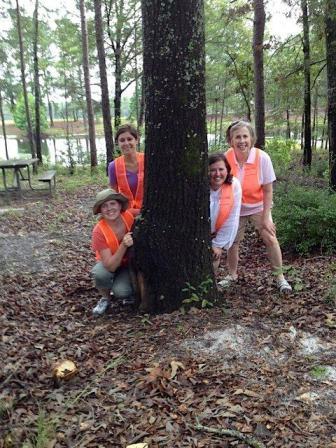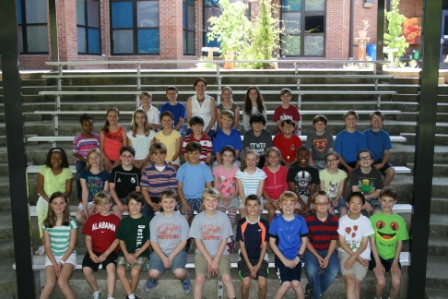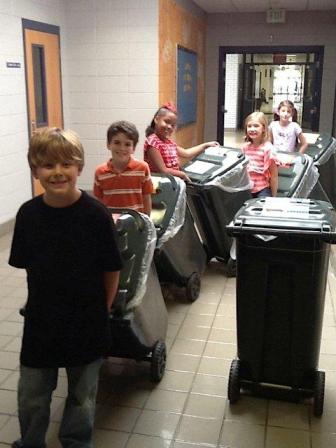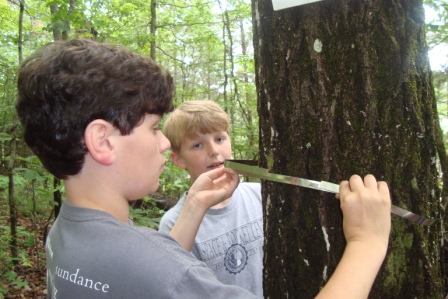
In 2013, Harriette Gwin Elementary achieved an Environmental Education (EE) “trifecta.” The school in Hoover, AL, near Birmingham, became one of the first in the country to earn recognition as a certified PLT GreenSchool, a U.S. Department of Education Green Ribbon School, and a National Wildlife Federation Green Flag Eco-School.
“Gwin Elementary School is a school that focuses on the present and future lives of our students,” said Principal Dr. Kimberly White in explaining why the school pursues EE. “We strive for excellence and to broaden the scope of influence our students will have on their communities and environment. Our students strive to make Hoover and our world ‘greener’ places to live.”
A school often needs an EE champion, and Gwin is no exception. For many years, enrichment teacher Traci Knight Ingleright has helped channel the interest of other teachers, staff, students, and families at all grade levels by integrating PLT and other activities into Gwin’s curriculum.
“Reconnecting with nature in a suburban landscape can be a challenge, but is a priority to our staff and administration,” noted Ingleright when she submitted the school’s application to become a Certified PLT Greenschool. “We have many different gardens that students created and use as places to explore natural habitats, such as the native bird sanctuary. This is just one example of an outdoor project, but many others have been utilized.”
The daughter and sister of foresters, Ingleright first became PLT-trained in 1994. She introduces PLT to pre-service teachers at Auburn and the University of Alabama. In return, the new and future teachers help her put on a two-day science camp or commit to working with other schools in the state.
Student Interests
 Ingleright teaches grades 3 through 5 in pull-out classes, but she stresses that PLT meets the needs of “all learning styles and students of all ages.”
Ingleright teaches grades 3 through 5 in pull-out classes, but she stresses that PLT meets the needs of “all learning styles and students of all ages.”
“My favorite part of the PLT investigations is that they allow students to take an active leadership role in their future while reinforcing the importance of their ‘voice,’” she said. “It’s a beautiful process to watch.”
A group of students who named themselves “Eco-Brains” took the lead in carrying out the Energy, Waste and Recycling, Water, School Site, and Environmental Quality investigations to become a Certified PLT GreenSchool. They also have mentored younger students. Several other grades are also active users of PLT.
“Any kid can do it, as long as you’re ready to get outdoors,” said Blaine Cook, a student transitioning from Gwin to middle school. Looking back, he said the experiences that stuck with him most were assisting the Wehle Nature Conservation Center with a bird-tagging project by creating safe bags for the birds, and investigating the air-quality impacts of car and bus idling and suggesting solutions.
 But perhaps the main lesson it taught him: “Kids can always make a difference in society.”
But perhaps the main lesson it taught him: “Kids can always make a difference in society.”
He is far from the only Gwin student who gains that insight. Ingleright administers a short questionnaire to students in third grade and again in fifth grade, asking them if they feel they can make a difference in the world. Typically, the positive response is about 30% in the beginning and 100% by fifth grade.
Blaine’s mother Lyric Crook also pointed to the role that EE has played in her son’s and other children’s development. “It teaches kids about working together, research, problem solving, and asking questions,” she said, adding that Blaine has spurred interest among the rest of his family.
When students realized that the school’s watering hoses could not reach a garden they planted, they problem-solved a solution by constructing 15 rain barrels. The barrels eliminated the need for irrigation systems for that garden plot and other native species gardens on the school grounds.
How Gwin Became a PLT Certified GreenSchool
Energy Investigation
Ingleright says outside experts are often thrilled to work with students—they just need to be asked. Case in point: Liz Cochran, an Energy Star Portfolio specialist, has helped students research and find ways to reduce energy usage. Cochran had offered to provide assistance to Alabama schools, but had not yet been contacted before working with Gwin. Through turning off unnecessary lights and other measures, the school reduced non-transportation energy use by 8.4% over the period of a year.
Waste & Recycling Investigation
Gwin partnered with Recycling Across America to launch a new and improved student-led recycling initiative. Students help in classroom recycling and sorting of materials, and the school actively promotes and practices reducing the overall amount of paper and other materials used.
Water Investigation
Students identified a problem to solve: the steps leading into the school remained wet and muddy after a rain. They realized that run-off was creating the problem and proposed rain barrels to catch the water. Fifteen rain barrels now eliminate the need for irrigation systems for the school’s native species gardens. Other water-reduction techniques include low-flow faucets, which, along with other measures, reduced domestic water use by 2%. And the mud on the stairs problem? Gone!
 School Site Investigation
School Site Investigation
Ingleright recommends starting with this investigation because “students love it.” Her students conducted a biodiversity audit of the school grounds, and the investigations dovetailed easily with language arts, PE, math, and other subjects. Many teachers now go outdoors with their classes regularly for science, math, and other lessons.
Environmental Quality Investigation
After a team of students researched air quality issues, Gwin became the first school in the district to implement EPA’s Indoor Air Quality Tools for Schools program and the first in the state to fly an Air Quality flag. Each day, students raise the appropriate flag, alerting the community about the status of the air that day. In addition, their investigation focused on parents’ cars idling during afternoon pick-up, which resulted in a change in policy to reduce exhaust.
Tapping Into Community Resources
Ingleright already realized that resource managers, planners, and others in the community want to work with schools and are looking for how to do that. The level of community interest, however, was even higher than she expected.
Outside experts are often thrilled to work with students—they just need to be asked, she noted. Case in point: An Energy Star Portfolio specialist has helped students research and find ways to reduce energy usage. She had offered to provide assistance to Alabama schools, but had not yet been contacted before working with Gwin. Through turning off unnecessary lights and other measures, the school reduced non-transportation energy use by 8.4% over the period of a year—and students gained valuable skills in data collection and analysis, as well as how to learn from and collaborate with a technical expert.
Tips From Gwin Elementary
- Questions, not answers
Ingleright does not give her students the answers—instead, she encourages them to find the answers on their own. It can lead to surprising opportunities. For example, they learned that Alabama does not have an Environmental Literacy Plan and Ingleright, who sits on the Governor’s Task Force to develop one, passed on their concerns. Several Gwin students are now involved in this effort.
- Start with the School Site investigation
If your school is trying to figure out its “entry point” into PLT GreenSchools certification, Ingleright recommends looking at the School Site investigation first. “Students love it,” she says, “and you’ll find many teachers start to utilize the outdoors more for their science, math, and other lessons.”
- Look at what you are already doing
Ingleright acknowledged that she initially found the applications for the various national programs daunting. But then she realized that Gwin was already doing a lot that met the criteria. Her suggestion: Look around and inventory what your school is already doing.
- Involve everyone
In addition to teachers, administration, students, and parents, Ingleright said the custodians, lunchroom staff, maintenance personnel, and school police are enthusiastic supporters of PLT GreenSchools and other EE activities.


